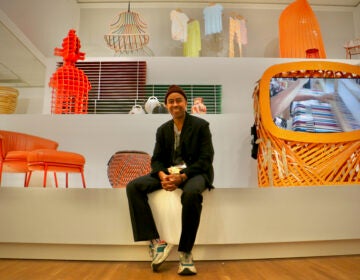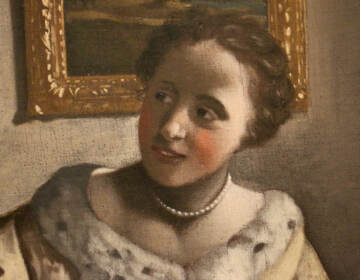Women artists celebrated in song at Philly Museum of Art
Birdie Busch will perform a suite of songs based on female artists in the collection of the Philadelphia Museum of Art.

Philadelphia singer-songwriter Birdie Busch at her home studio in Germantown. Busch wrote eight original songs inspired by the art of women in the collection of the Philadelphia Museum of Art, and will perform them Friday night at the museum. (Emma Lee/WHYY)
A few years ago, the Philadelphia musician Birdie Busch stumbled across a paperback copy of “Goddesses in Everywoman,” psychologist Jean Shinoda Bolen’s 1984 book about personality archetypes described by Greek goddesses.
Taken by the Jungian approach to self-awareness, Busch set out to write songs about goddesses, or imagined relationships with goddesses, that were a little less “self-helpy.”
“We’re constantly juggling multiple roles. Especially as women get older, you feel like you’re taking on all these different archetypes,” said Busch. “I wanted to process it in a way that felt more interesting and, literally, just fun.”
Busch wrote song about Hestia, goddess of the hearth; Artemis, goddess of the hunt; and Hera, goddess of marriage.
“There’s one of Athena, who is the goddess of wartime and, when not at war, handicraft,” she said. “Which I think is funny … ‘I’m not in battle right now, so I might as well knit.’”
Toggling between being a warrior and a crafter pretty much describes the life of an independent musician. Busch (whose real name is Emily) has recorded five albums in 13 years. Some are self-released.
This cycle of goddess songs caught the attention of the Philadelphia Museum of Art. Its coordinator of evening programs, Catherine Ricketts, approached Busch with a commission to write another song cycle about women artists represented in the museum’s collection, and debut those songs at the museum’s regular Friday night performance showcase.
“My team and I decided we wanted to do a bigger moment for spring 2019,” said Ricketts. “I thought about Women’s History Month, and I came across Birdie’s website and saw she had developed this goddess project.”
Busch was invited to peruse the galleries in the museum — as well as the approximately 250,000 pieces in the archive, accessible online — to find women who would inspire song.
“I hunted works on the website, rabbit-hole style,” she said. “I also was asking friends for their favorite female visual artists. That was interesting, to look up things by suggestion. A lot of people considered their favorite female artist, but none of them are in the collection.”
She quickly realized that the museum — like the repositories of most large, encyclopedic collections — has dramatically fewer women artists than men.
“That’s one of the reasons I wanted to work with Birdie,” said Ricketts. “To see what her response would be to our collection, and give her the freedom to present that response publicly.”
“I felt like [Ricketts] put on my plate this idea that I trusted right away,” said Busch. “I know that she trusted it, too, and was taking it seriously with as much reverence as I do.”
Busch pulled out nine artists to write songs about, including Louise Bourgeois, Sister Corita Kent, Sophie Taeuber-Arp, photographer Barbara Crane, and the Cherokee painter Kay WalkingStick.
Some songs are about the art more than the artist. Sarah Bates, an early 19th-century Shaker schoolteacher from rural Pennsylvania, created “gift drawings,” illustrations of symmetric shapes and simple patterns believed to be divinely inspired.
“They looked like strange, futuristic charts and graphs,” said Busch. “They were religious, but alien.”
It inspired her to write “God Feels Like a Woman.”
Wrapped foil
All inside
A red glass candy bowl.
She’d lift the top
And time would stop
It was me she loved to spoil
Letters sent
In the mail
A bird’s nest valentine.
God feels like a woman
A endless chain of women
Other artists had more robust biographies available than Bates. Busch discovered Alma Thomas, an African-American who was the first artist to graduate from Howard University in 1924, then spent the next 35 years as a schoolteacher. At 68, she retired and began her art career, making abstract paintings such as “Hydrangeas Spring Song,” a cascade of blue marks across a white canvas.
“I particularly connected with that color blue,” said Busch. “Those little shapes look like confetti.”
The song Thomas inspired is an instrumental, loosely composed to allow for improvisation. “We wanted to make something that sounded like the reawakening back into spring after the March slog,” said Busch.
At the Art Museum on Friday, the two-set concert will be accompanied by projections of the artwork that inspired the music, and Busch’s own paintings.
WHYY is your source for fact-based, in-depth journalism and information. As a nonprofit organization, we rely on financial support from readers like you. Please give today.





